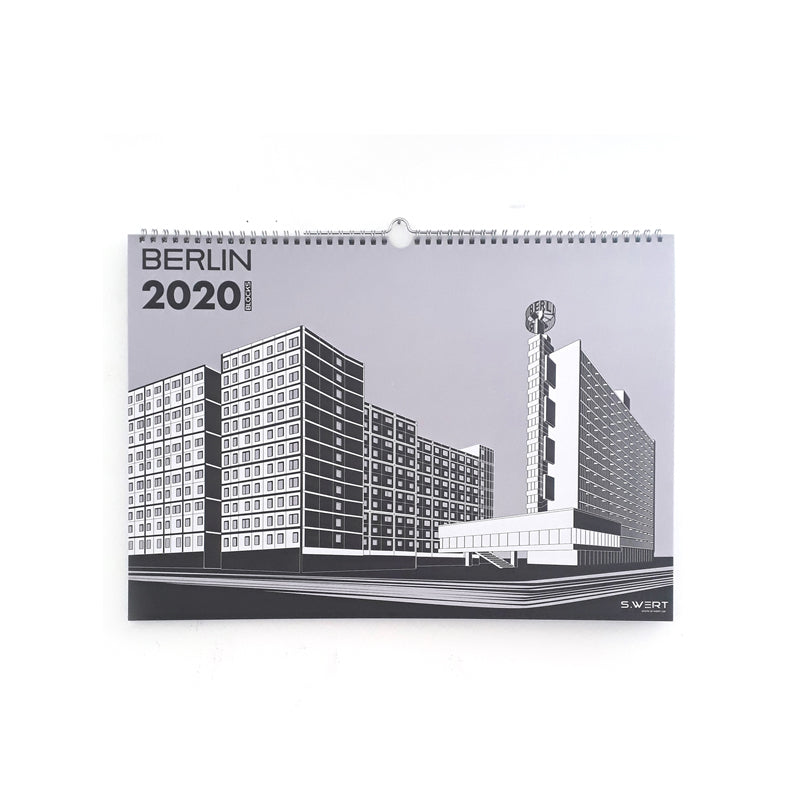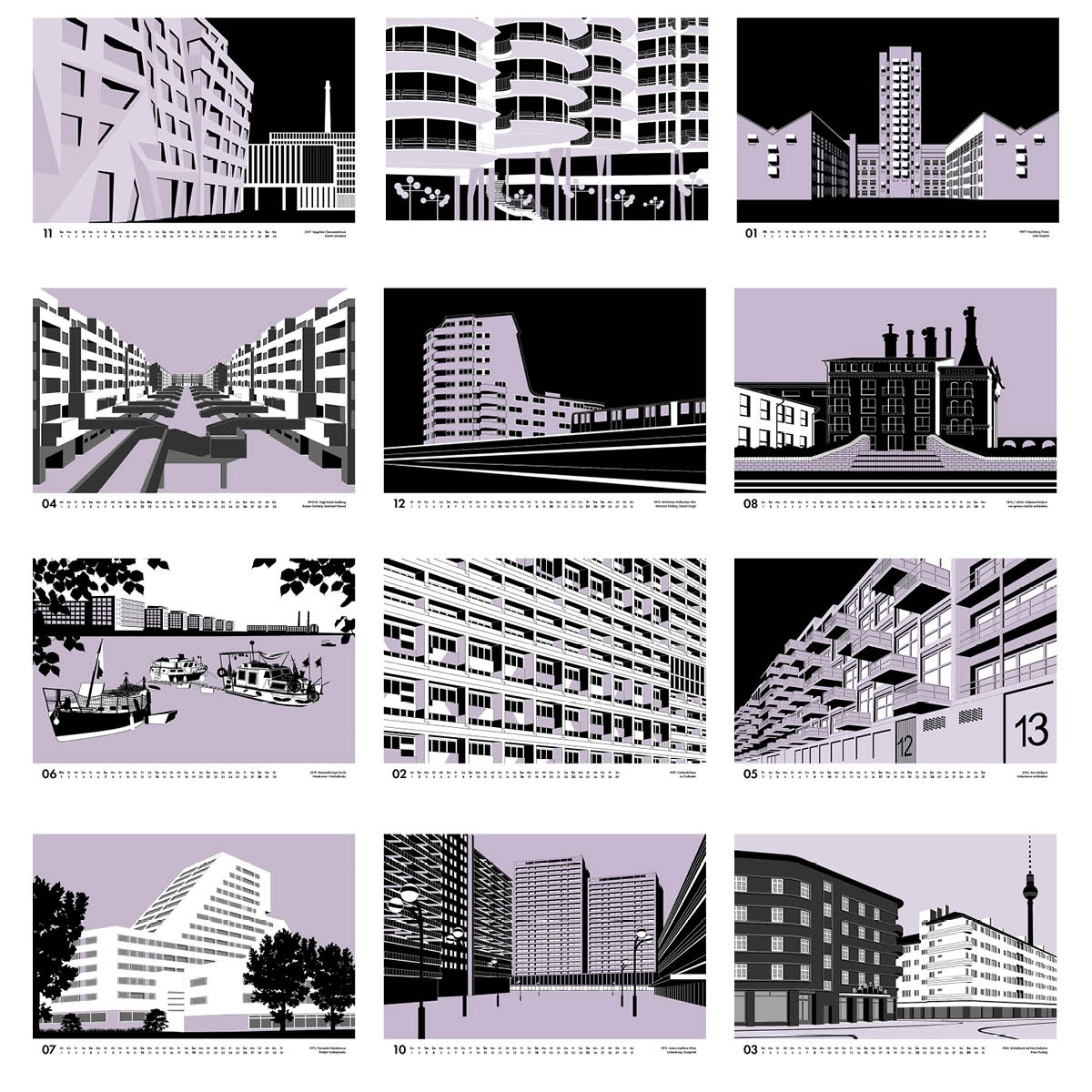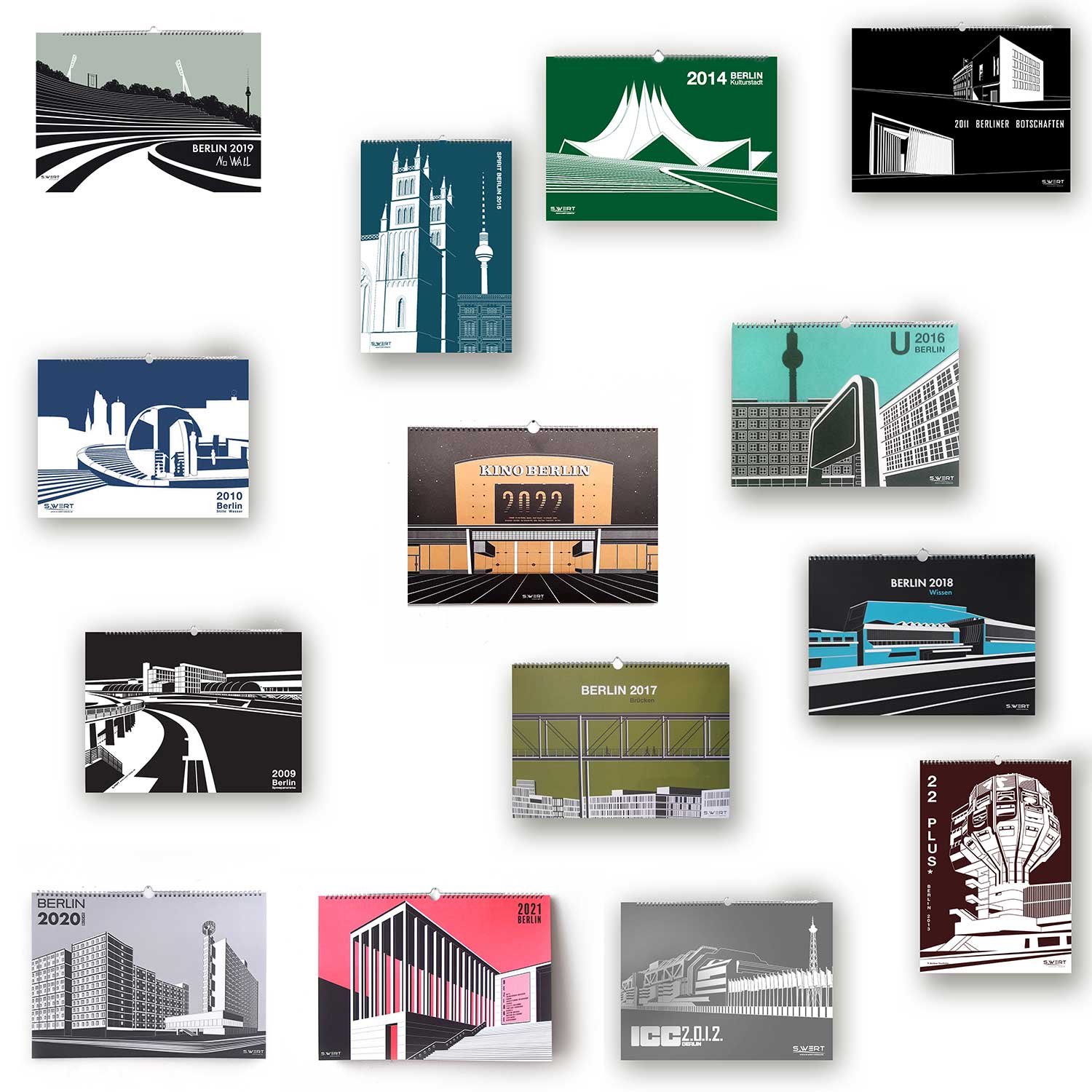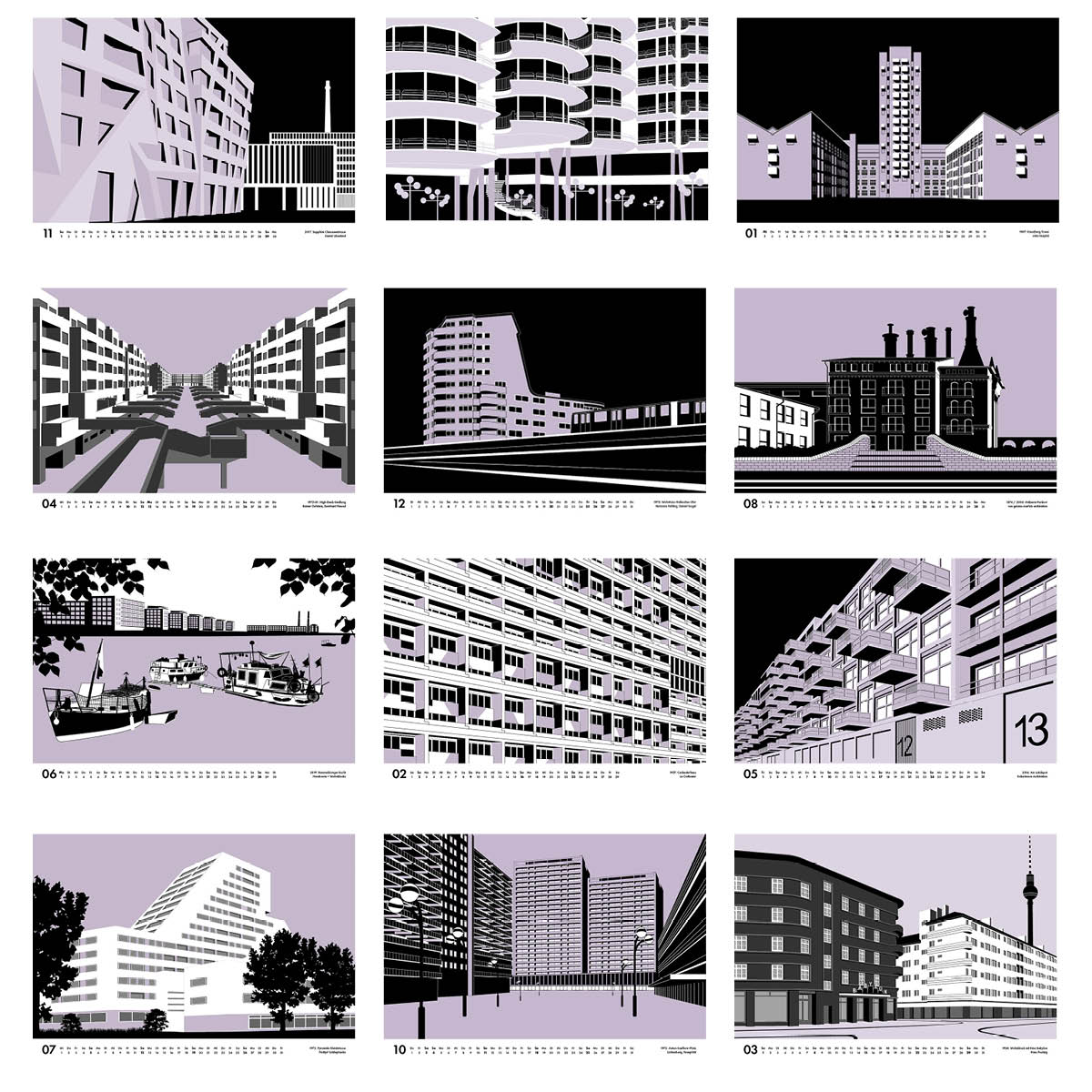s.wert
Berlin Calendar 2020: Blocks
Berlin Calendar 2020: Blocks
Couldn't load pickup availability
The s.wert calendar 2020 is dedicated to the topic of living. Rent control, rent caps, gentrification and expropriation - the topic of living in the capital affects everyone and is discussed in a powerful, political and emotional way. We illuminate the topic with thirteen illustrations from a visual and architectural perspective - from Poelzig's residential buildings of the 1920s to the new buildings at Park am Gleisdreieck.
It starts in January with a beacon of postmodernism - the Kreuzbergtower by John Hejduk from 1987.
The face of the tower, with its green, metallic eyebrow awnings, was threatened by redevelopment a few years ago. Petitions that attracted the media attention from architects from Germany and abroad, including prominent representatives such as Peter Eisenman, Daniel Libeskind, Jan Kleihues and Matthias Sauerbruch, meant that the Kreuzberg Tower retained its typical shape of the time.
February is structured by the facade of the Corbusierhaus. The Corbusier House was built in 1957 as part of the International Building Exhibition according to Le Corbusier's plans and is considered the forerunner of prefabricated buildings. Le Corbusier's contribution to the Interbau (also known as IBA 57 for short) was too large to fit in the Hansaviertel, so the residential building was built near the Olympic Stadium. The facade structure reflects the interior of the building, which houses maisonette apartments and single-storey apartments.
A view of the Hans Polezig buildings at Rosa Luxemburg Platz can be seen in March. When it was built in 1928, the square was called Bülowplatz. The building ensemble in Mitte is the only surviving ensemble by Poelzig in Berlin.
In April, the Neukölln High Deck settlement can be seen - a social housing estate from the 1970s and 1980s. The innovative large settlement with raised, green paths, which was coveted in its early days, developed into a social hotspot after reunification. District management and art campaigns are now intended to help the district improve its image.
May shows the trendy industrial look new buildings by Robertneun am Park am Gleisdreieck. The two architects Nils Buschmann and Tom Friedrich trade as Robertneun. They have been pursuing the idea of realizing housing on the edge of the park instead of purely commercial since 2006 - when new housing construction was not a big issue in Berlin. In 2016 the red blocks were completed.
The idyllic picture of the Rummelsburg Bay that can be seen in June is deceptive - because different forms of living collide here. Views of the bay are shared by houseboat owners, residents of '90s-built apartment buildings, and homeless people in tented camps -- and it's not without conflict. The development plan approved in spring 2018, which envisages that several large apartment blocks with commercial space and the controversial "Coral World" amusement park should be built between Ostkreuz and Rummelsburger See, creates additional potential for conflict.
In July, a huge ship glides through Schöneberg – Fridtjof Schliephacke's “Pyramid” on Kleiststrasse. The imposing residential building was completed in 1972 and has been a listed building since 2017.
The malthouse in Pankow can be seen in August. Where malt used to be produced for beer production, people now live in condominiums. In 1874, the Schultheiss brewery erected the industrial buildings, and from 2008 to 2011 the listed ensemble was renovated and converted into apartments.
The Expressionist residential building by Baller & Baller from 1978 adorns the September calendar. Baller buildings can be found in many parts of Berlin and set colorful accents between stone and concrete. The unmistakable buildings with their playful elements, material mix and organic forms are the birds of paradise among the Berlin blocks.
October is a month for prefab fans. You can see Anton-Saefkow-Platz. The square, named after a Nazi resistance fighter, is located in the district of Fennpfuhl, in the district of Lichtenberg. Here, WBS 70 panels dominate the cityscape.
In November we are showing the Sapphire – the only residential building in Berlin designed by Daniel Libeskind. The building, which is intended to resemble a precious stone with its slanting, peaks and titanium facade, is located opposite the BND headquarters in Berlin Mitte.
On the last page of the calendar you can see the striking high-rise apartment building by Hermann Fehling and Daniel Gogel on Hallesches Ufer. The building on the Landwehr Canal was completed in 1970. The architects created succinct and refined post-war modernist buildings between 1953 and 1990, with the premise that “a building should… be fun for its occupants.” (Daniel Gogel) With this in mind, we wish you lots of fun with the 2020 BERLIN BLOCKS calendar from s.wert.
Materials
Materials
spiral binding
Recycled paper 240 g/sqm
Limited edition
Shipping & Returns
Shipping & Returns
Pick up in store: free
Shipping Germany: €4.99
Shipping EU: €14.99
Shipping CH + GB: €16.99
Sorry, no NON-EU shipping
Delivery time: 2-3 working days
The products can be returned within 14 days without giving a reason. The buyer bears the costs of the return. Details can be found in our general terms and conditions and our cancellation policy.
Dimension
Dimension
A3: 42*29.7cm
CareInstructions
CareInstructions
GPSR Hinweise
GPSR Hinweise
Allgemeine Hinweise für alle Produkte:
Nicht für Kinder unter 3 Jahren geeignet.
Produkte nur für den vorgesehenen Verwendungszweck nutzen.
Verpackungsmaterialien (z. B. Folien, kleine Teile) können gefährlich sein. Bitte von Kindern fernhalten.
Allgemeine Sicherheitshinweise:
Brandgefahr: Kalender können leicht entflammbar sein. Halten Sie sie von offenen Flammen, Heizquellen und anderen Zündquellen fern.
Erstickungsgefahr: Verpackungsmaterialien (z. B. Plastikfolien) können für Kinder gefährlich sein. Außerhalb der Reichweite von kleinen Kindern aufbewahren.
Schnittgefahr: Die Kanten von Kalendern können scharf sein. Seien Sie vorsichtig beim Umgang mit ihnen.
Materialien: Kalender können aus verschiedenen Materialien bestehen, die unter Umständen Allergien auslösen können. Informieren Sie sich über die verwendeten Materialien.
Chemikalien: Bei Kalendern mit speziellem Druck oder Oberflächenbehandlungen können chemische Rückstände vorhanden sein. Vermeiden Sie längeren Hautkontakt und den Kontakt mit Lebensmitteln.
Warnhinweise für Kinder:
Nicht für Kinder unter 3 Jahren geeignet.
Verpackungsmaterialien von Kindern fernhalten.
Aufsicht von Erwachsenen erforderlich.
Zusätzliche Hinweise für Kalender:
Verwenden Sie nur geeignete Befestigungsmaterialien für die jeweilige Wandbeschaffenheit.
Bringen Sie Kalender nicht in der Nähe von Wärmequellen oder in feuchten Umgebungen an.
Entfernen Sie beschädigte Kalender sofort.
Bei Kalendern mit Farben, die durch UV-Strahlung verblassen können, diese nicht im direkten Sonnenlicht aufhängen.
Herstellerinformationen
s.wert design
Sandra Siewert
Brunnenstrasse 191
10119 Berlin
E-Mail:gspr@s-wert.de
Verantwortliche Person für die EU
Sandra Siewert
Brunnenstrasse 191
10119 Berlin
shares



Berlin calendar
Architecture + Illustration Since 2009 we have been designing a Berlin calendar with graphic city views every year. The focus is on Berlin architecture. The calendar appears as a "LIMITED EDITION". The s.wert calendar is often sold out in December.

